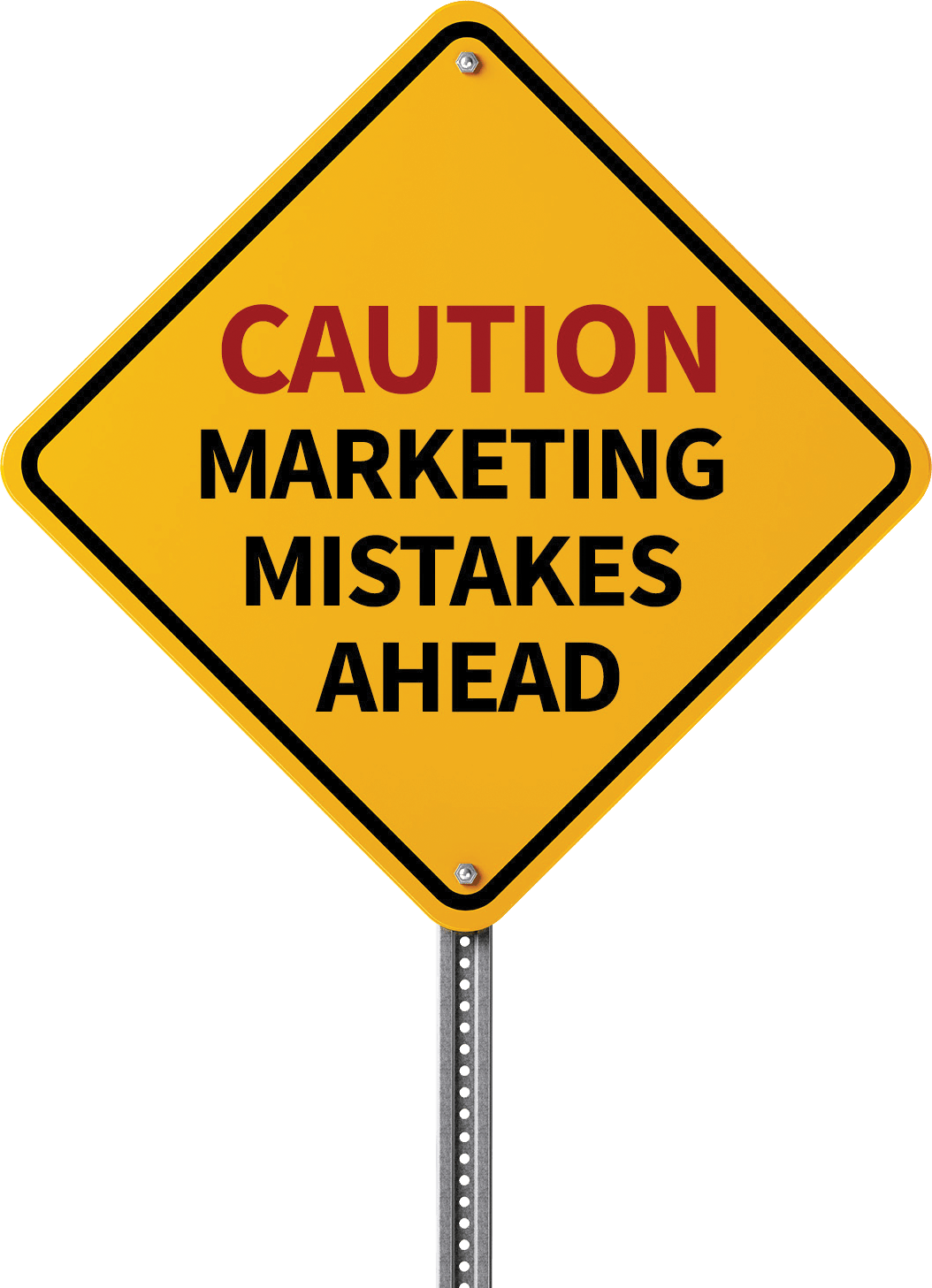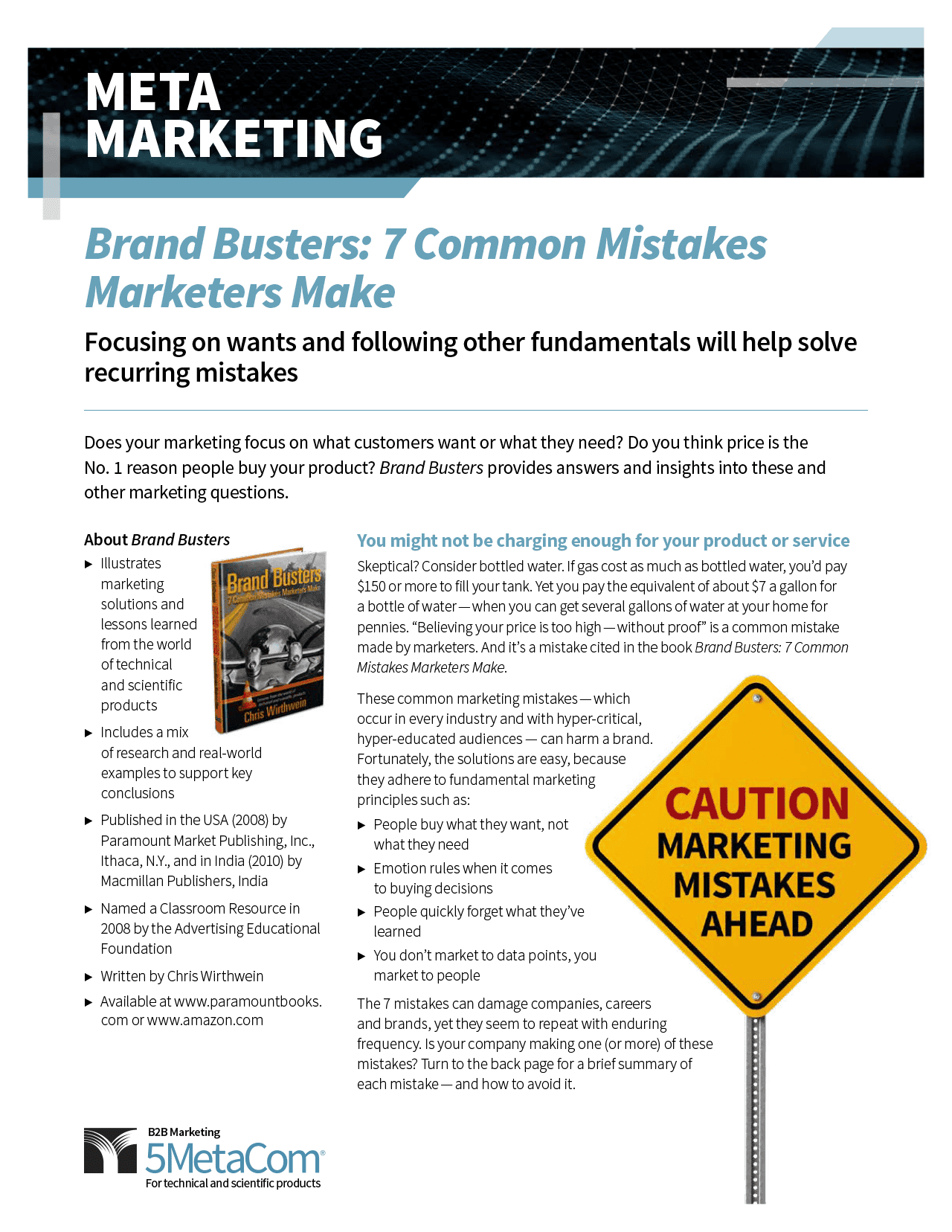Brand Busters: 7 Common Mistakes Marketers Make
Focusing on wants and following other fundamentals will help solve recurring mistakes
Does your marketing focus on what customers want or what they need? Do you think price is the No. 1 reason people buy your product? Brand Busters provides answers and insights into these and other marketing questions.
You might not be charging enough for your product or service
Skeptical? Consider bottled water. If gas cost as much as bottled water, you’d pay $150 or more to fill your tank. Yet you pay the equivalent of about $7 a gallon for a bottle of water — when you can get several gallons of water at your home for pennies. “Believing your price is too high — without proof” is a common mistake made by marketers. And it’s a mistake cited in the book Brand Busters: 7 Common Mistakes Marketers Make.
These common marketing mistakes — which occur in every industry and with hyper-critical, hyper-educated audiences — can harm a brand. Fortunately, the solutions are easy, because they adhere to fundamental marketing principles such as:
- People buy what they want, not what they need
- Emotion rules when it comes to buying decisions
- People quickly forget what they’ve learned
- You don’t market to data points, you market to people
The 7 mistakes can damage companies, careers and brands, yet they seem to repeat with enduring frequency. Is your company making one (or more) of these mistakes? See below for a brief summary of each mistake — and how to avoid it.

Is your company making one (or more) of these mistakes?

Talking “needs” instead of “wants”
Marketers tend to talk about buyer’s needs (a 2-terabyte hard drive) instead of the buyer’s wants (a place to store photos and videos). But need is an arrogant position. It says, “Never mind what you want. We’re the experts here, and here’s what’s right for you — according to me.”
Appeal to emotion
When it comes to selling, emotion (not logic) is primary, regardless of your audience. People don’t buy what they need — people buy what they want. Wants are the things people care about enough to take action. You need to eat, but you want a hamburger and iced tea.
Falling in love with your product (instead of your customer)
When asked to differentiate their product from other products, marketers often say, “We have superior quality.” But “quality” is an empty, general and virtually meaningless word. And quality describes features instead of customer wants. You don’t want “quality health care.” You want to feel better.
Talk to your customers like you talk to your family
You don’t talk down to your spouse or your children. You don’t baffle them with big words. You speak clearly and intelligently. Also, ask yourself, what pain does your product fix? Or what new possibilities/opportunities can it deliver?
Believing that marketing is a science or an art
Many marketers believe in research and what it can tell them. They believe in creating measurable marketing programs. They’re keen on attaching ROI to everything. Others see marketing as an art. They correctly understand that sometimes you have to follow your gut instinct.
Use the science to build a framework for the art
Research can tell you valuable information about who your audience is, what they respond to, etc. But a purely scientific approach may suck the soul out of your messages. Avoid this mistake by using art for the visuals and words that inspire customers to act. Let the science dictate what you do with it.
Trying to please everyone
Many marketers insist everyone in their product category should be interested in buying their product, so they design messages to appeal to everyone. But in trying to appeal to everyone, they weaken their message to the point where they appeal to no one.
Make fewer but stronger claims
Find out the strengths of your brand that resonate with customers. Research shows that if you make a lot of claims in your ads, you’re inviting greater skepticism than if you make just one strong claim. Successful brands find their audience and appeal to them with a focused message.
Forgetting that people forget
Studies show we forget 75% of new information we learn after 7 days. After 30 days, we forget 95% of what we’ve learned. So if you ever wonder why you’re hazy about the details of a news story you read a week ago, now you understand that it’s normal.
Repeat yourself frequently
Without frequent repetition of your marketing messages, people forget about you. Building awareness is a step on the road to preference. And frequency builds awareness. Awareness leads to preference. People prefer things they’re more familiar with.
Believing your price is too high, without proof
It’s a mistake to think price alone drives purchase decisions. Do people really buy on price? If they did, why isn’t everyone driving a Kia? If price were the most important factor in the buying decision, low price would always win. Clearly, it does not.
Equate your price with greater value
Instead of lowering your price, add value. What can you add to your product/service to make it more valuable? In most cases, high price suggests high value.
Believing you must sell your product on an economic basis.
Lots of marketers start with ROI and stay there. Return on investment, gross profit, net return — all helpful, but they’re just data points. How distinctive is your brand when it’s reduced to numbers on a spreadsheet? If your product has great ROI, ask why. It’s probably because of something it does — probably because of one of its benefits.
Differentiate your brand with benefits, not numbers
Some other factor — ease of use, dependability, performance, innovation or even profit — will trump ROI and actually lead to a sale. Ultimately, the brand that gives the customers what they want ends up the winner. And in most cases, that “want” is way beyond money and way beyond the numbers.

About Brand Busters
- Illustrates marketing solutions and lessons learned from the world of technical and scientific products
- Includes a mix of research and real-world examples to support key conclusions
- Published in the USA (2008) by Paramount Market Publishing, Inc., Ithaca, N.Y., and in India (2010) by Macmillan Publishers, India
- Named a Classroom Resource in 2008 by the Advertising Educational Foundation
- Written by Chris Wirthwein
- Available at www.paramountbooks.com or www.amazon.com
